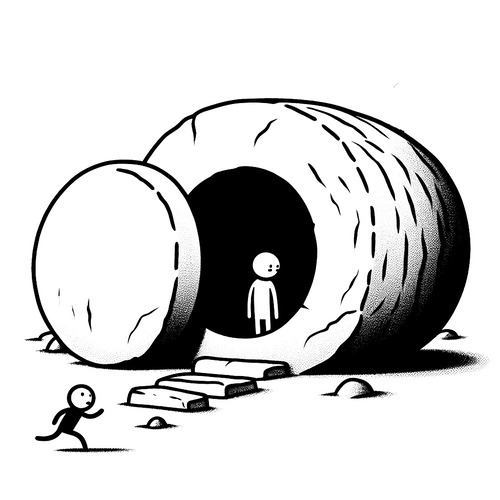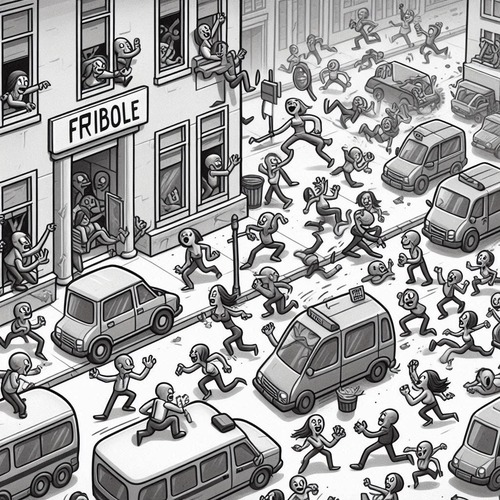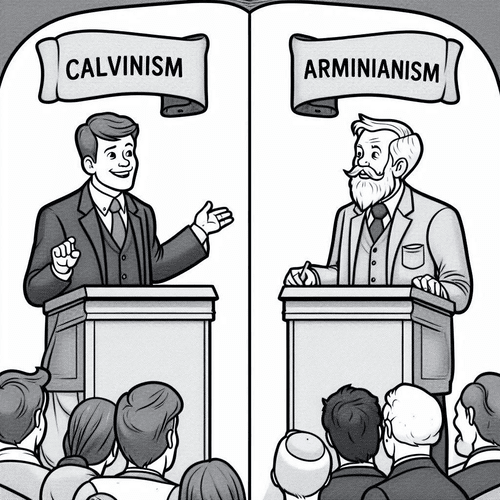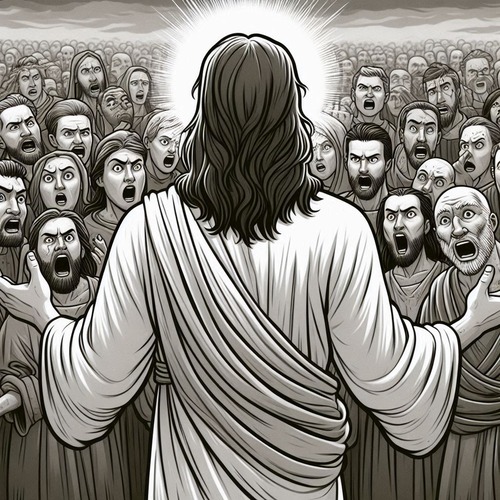The Easter Miracle: What John Saw at the Tomb that Sparked Faith
It’s one of the most intriguing moments in the Gospel accounts of Jesus’ resurrection. Two disciples, Peter and John, race to the tomb on hearing Mary Magdalene’s startling news that Jesus’ body is missing. John arrives first but hesitates at the entrance. Peter, true to character, charges straight in. Then John enters, and something extraordinary happens: “He saw and believed” (John 20:8).
But what exactly did John see? What evidence in that empty tomb was so compelling it transformed a discouraged follower into the first believer in the risen Christ?
THE DISCOVERY OF THE EMPTY TOMB
To understand this pivotal moment, we need to set the scene. It’s early Sunday morning, the third day after Jesus’ crucifixion. His body had been hastily placed in a tomb as the Sabbath approached. Now, Mary Magdalene had gone to the tomb, likely to complete the burial preparations interrupted by the Sabbath.
Finding the stone rolled away, Mary doesn’t investigate further but runs to tell Peter and John: “They have taken the Lord out of the tomb, and we don’t know where they have put him!” (John 20:2). Evidently, her conclusion is theft or removal, not resurrection.
The two disciples immediately race to the tomb. John, younger and faster, arrives first but stops at the entrance. Perhaps respect, fear, or Jewish concerns about tomb defilement held him back. Peter arrives moments later and, characteristically impulsive, enters immediately. Then John follows.
A CLOSE READING OF THE TEXT
The apostle recounts the moment with carefully chosen language (John 20:8). The Greek text uses the verb eiden (he saw) followed by episteusen (he believed). This combination suggests a moment of profound insight—not just visual observation but a deeper understanding.
Interestingly, the next verse adds: “They still did not understand from Scripture that Jesus had to rise from the dead” (John 20:9). This apparent contradiction—believing yet not fully understanding—suggests John’s belief was based on what he observed, even before he connected it to prophecy.
THE BURIAL CLOTHES: THE KEY EVIDENCE
What John saw were burial clothes, but their condition and arrangement appear to have been extraordinary. The text provides two specific details:
“He saw the strips of linen lying there, as well as the cloth that had been wrapped around Jesus’ head. The cloth was still lying in its place, separate from the linen.” (John 20:6-7)
To appreciate the significance of this, we need to understand first-century Jewish burial customs. Bodies were typically wrapped in linen clothes with spices placed between the layers. The head was often wrapped separately with a face cloth (soudarion in Greek).
Three main theories explain why these burial cloths convinced John:
The Collapsed Graveclothes Theory
This compelling interpretation suggests John saw the linen wrappings lying flat, collapsed in on themselves, but still retaining the shape of Jesus’ body—like an empty cocoon or chrysalis. The head cloth remained “rolled up” or “folded” (entetuligmenon) in its place where the head had been.
This arrangement would be impossible if the body had been stolen. Thieves would either take the wrapped body entirely or, if they needed to remove the valuable burial linens, would leave them scattered about. They certainly wouldn’t take time to carefully unwrap the body and leave the cloths in their original position.
The position of the clothes suggested something unprecedented: the body had somehow passed through the wrappings, leaving them undisturbed but empty.
The Orderly Tomb Theory
A second theory focuses on the neat, orderly condition of the tomb. The face cloth was “folded up” or “rolled up” and placed separately. This deliberate arrangement contradicted any scenario involving grave robbery, which would have left chaos and disorder.
The care taken with the burial clothes suggested purpose and intention, not the haste and carelessness of thieves. It pointed to something miraculous rather than criminal.
The Fulfillment of Scripture Theory
Though John 20:9 states they did not yet understand Scripture’s prediction of resurrection, John may have recalled Jesus’ predictions of his death and resurrection. Seeing the empty tomb with its orderly grave clothes may have triggered the memory of Jesus’ words: “Destroy this temple, and I will raise it again in three days” (John 2:19).
While Scripture understanding would come later, the seed of recognition may have been planted in that moment.
FROM SEEING TO BELIEVING: THE BIRTH OF RESURRECTION FAITH
What makes John’s experience remarkable is that he believed before seeing the risen Christ himself. Unlike Thomas, who declared, “Unless I see… I will not believe” (John 20:25), John moved from physical evidence to faith.
This creates a bridge between the disciples who saw Jesus in person and later believers—including us—who’d come to faith through testimony rather than direct witness. John’s experience validates evidence-based faith and shows that believing doesn’t require blind acceptance.
Jesus later tells Thomas: “Because you have seen me, you have believed; blessed are those who have not seen and yet have believed” (John 20:29). John stands at the transition point between these two types of faith—he didn’t see the risen Jesus at that moment, but he saw compelling evidence of the resurrection.
CONCLUSION: WHAT JOHN SAW
What John saw in that tomb on Easter morning transformed him. The arrangement of burial clothes—likely collapsed yet intact, as if the body had simply passed through them—provided physical evidence of something supernatural.
This wasn’t merely an absence (a missing body) but a positive sign of resurrection. The grave clothes weren’t just empty; they testified to a miracle.
John’s purpose in recording these details becomes clear in his statement near the end of his Gospel: “These are written that you may believe that Jesus is the Messiah, the Son of God, and that by believing you may have life in his name” (John 20:31).
The evidence that convinced John is testimony for all who came after him. The empty cocoon of grave clothes was the silent witness to the butterfly of resurrection—the first evidence of the Easter miracle that continues to spark faith 2000 years later.
WHAT JOHN SAW: RELATED FAQs
Could John have been hallucinating at the tomb or experiencing grief-induced delusions, perhaps? Modern sceptics often suggest psychological explanations for resurrection accounts, but this doesn’t align with the evidence. John’s description is precise and detailed, focusing on physical objects (burial clothes) rather than ethereal visions. Furthermore, the transformation of the disciples from fearful to boldly proclaiming the resurrection—even to the point of martyrdom—suggests they were convinced by tangible evidence, not wishful thinking.
- What insights do archaeological discoveries about first-century tombs add to our understanding? Archaeological excavations of first-century Jewish tombs in Jerusalem have revealed important details about burial practices that illuminate John’s account. These tombs typically featured stone benches where bodies were laid, with evidence of burial clothes and spices consistent with Gospel descriptions. The “rolled up” nature of the head cloth may refer to how it maintained its rounded shape where it had been wrapped around Jesus’s head, a detail that would be meaningful to those familiar with Jewish burial customs.
- Why did John believe while Mary Magdalene, who also saw the empty tomb, initially did not? Mary Magdalene’s initial conclusion was that someone had taken Jesus’ body, revealing she wasn’t predisposed to believe in resurrection. John, however, entered the tomb and examined the burial clothes carefully, seeing something in their arrangement that convinced him of supernatural intervention. This difference highlights how the same evidence can yield different conclusions depending on one’s level of engagement with it—Mary saw absence, while John recognised presence.
How does John’s immediate belief compare with Thomas’s famous doubting? John believed based on physical evidence without seeing the risen Christ, while Thomas declared he needed to see and touch Jesus himself. This creates a fascinating spectrum of faith responses among the disciples that mirrors the variety of ways people come to faith today. Jesus’s gentle rebuke to Thomas and blessing on those “who have not seen and yet have believed” suggests John’s evidence-based faith may represent a model more applicable to subsequent generations of believers.
- What does NT Wright’s The Resurrection of the Son of God add to our understanding of this passage? Wright’s comprehensive work examines resurrection beliefs in the ancient world, noting no one expected an individual resurrection before the end times. He argues only an actual resurrection can explain the disciples’ radical shift from despair to confident proclamation within days of the crucifixion. Wright’s historical analysis shows the empty tomb and grave clothes represent a crucial piece of evidence—and John’s immediate recognition of their significance demonstrates his intimate understanding of Jesus’ teachings.
- Did other ancient texts or traditions expand on what John might have seen? While not canonical, some early Christian writings expand on the grave clothes description, with texts such as the Gospel of Peter describing luminous grave clothes. Church fathers like Chrysostom and Augustine wrote commentaries emphasising the significance of the neatly arranged burial clothes as evidence against theft. These traditions underscore how early Christians recognised the evidential value of what John witnessed, seeing the arrangement of burial clothes as a powerful testimony to resurrection rather than removal.
How might modern forensic science approach the evidence John saw? Modern forensic scientists would analyse how a body could leave burial wrappings intact while no longer being contained by them. Some scholars have suggested the image on the Shroud of Turin (regardless of its authenticity debate) demonstrates how radiation might affect burial cloths, potentially leaving them collapsed but intact. Forensic analysis would likely conclude that the condition of the cloths described in John’s gospel represents a physically inexplicable scenario—supporting John’s conclusion that something supernatural had occurred.
WHAT JOHN SAW: OUR RELATED POSTS
Editor's Pick
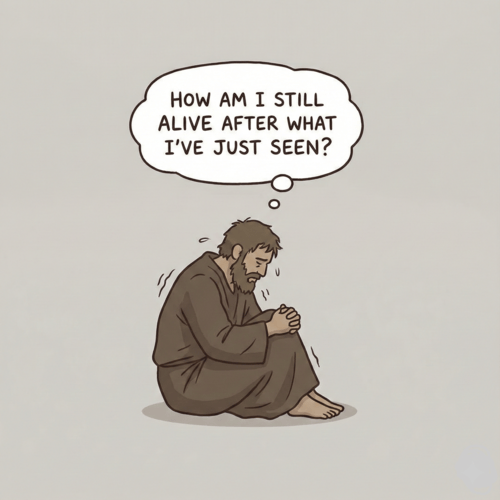
The Throne-Room Vision: Who Did Isaiah See?
The scene is unforgettable: Isaiah stands in the temple, and suddenly the veil between heaven and earth tears open. He [...]
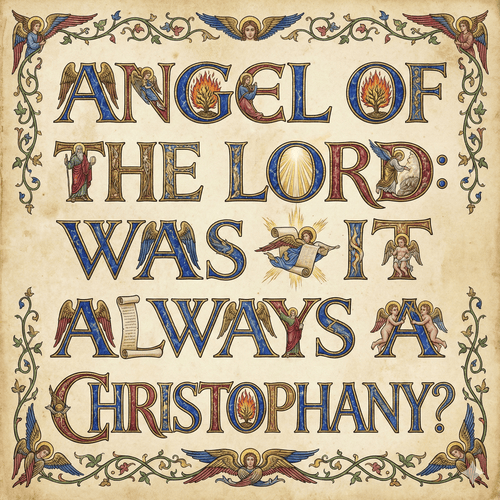
The Angel of the Lord: Can We Be Certain It Was Christ All Along?
Throughout the Old Testament, a mysterious figure appears: the Angel of the LORD. He speaks as God, bears God’s name, [...]
SUPPORT US:
Feel the Holy Spirit's gentle nudge to partner with us?
Donate Online:
Account Name: TRUTHS TO DIE FOR FOUNDATION
Account Number: 10243565459
Bank IFSC: IDFB0043391
Bank Name: IDFC FIRST BANK


